Forbidden Planet
7.4 /10 2 Votes
98% Rotten Tomatoes Genre Action, Adventure, Family Duration Language English | 7.7/10 IMDb Director Fred M. Wilcox Adapted from The Tempest Country United States | |||||||||||||||||||||||||||||||||
 | ||||||||||||||||||||||||||||||||||
Release date March 15, 1956 (1956-03-15) Writer Cyril Hume (screen play), Irving Block (based on a story by), Allen Adler (based on a story by) Screenplay Cyril Hume, Allen Adler, Irving Block Cast Walter Pidgeon (Dr. Edward Morbius), Anne Francis (Altaira Morbius), Leslie Nielsen (Commander John J. Adams), Warren Stevens (Lt. 'Doc' Ostrow), Jack Kelly (Lt. Jerry Farman), Richard Anderson (Chief Engineer Quinn)Similar movies Godzilla , Pirates of the Caribbean: Dead Man's Chest , Armageddon , Mothra vs. Godzilla , Godzilla's Revenge , Invasion of Astro-Monster Tagline Earthmen on a fabulous, peril-journey into outer space! | ||||||||||||||||||||||||||||||||||
Forbidden planet official trailer 1 leslie nielsen movie 1956 hd
Forbidden Planet (also known as Fatal Planet) is a 1956 American science fiction film from MGM, produced by Nicholas Nayfack, directed by Fred M. Wilcox and starring Walter Pidgeon, Anne Francis and Leslie Nielsen. Shot in Eastmancolor and CinemaScope, it is considered one of the great science fiction films of the 1950s, and a precursor of contemporary science fiction cinema. The characters and isolated setting have been compared to those in William Shakespeare's The Tempest. Its plot contains certain story analogues to the play.
Contents
- Forbidden planet official trailer 1 leslie nielsen movie 1956 hd
- Plot
- Production
- Reception
- Home media
- Novelization
- Soundtrack
- Track list
- Costumes and props
- In popular culture
- Cancelled remake
- References
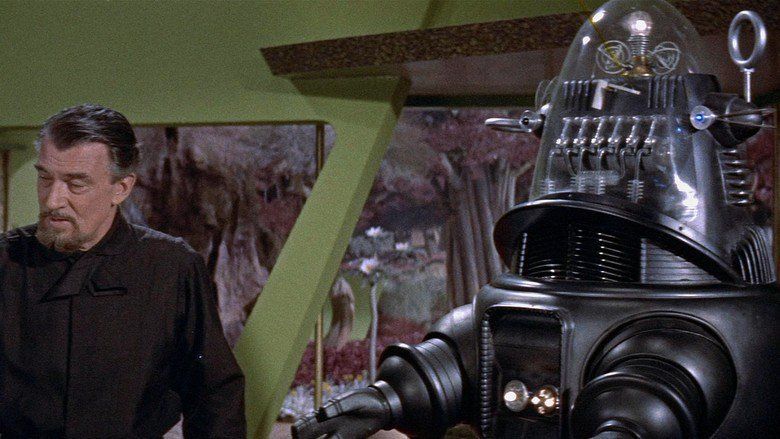
Forbidden Planet is notable for pioneering several aspects of science fiction cinema. It was the first science fiction film to depict humans traveling in a faster-than-light starship of their own creation. It was also the first to be set entirely on another planet in interstellar space, far away from Earth. The Robby the Robot character is one of the first film robots that was more than just a mechanical "tin can" on legs; Robby displays a distinct personality and is an integral supporting character in the film. Outside of science fiction, the film was groundbreaking as the first of any genre to use an entirely electronic musical score, courtesy of Bebe and Louis Barron.

Forbidden Planet's effects team was nominated for the Academy Award for Best Visual Effects at the 29th Academy Awards. In 2013, the picture was entered into the Library of Congress' National Film Registry, being deemed "culturally, historically, or aesthetically significant".
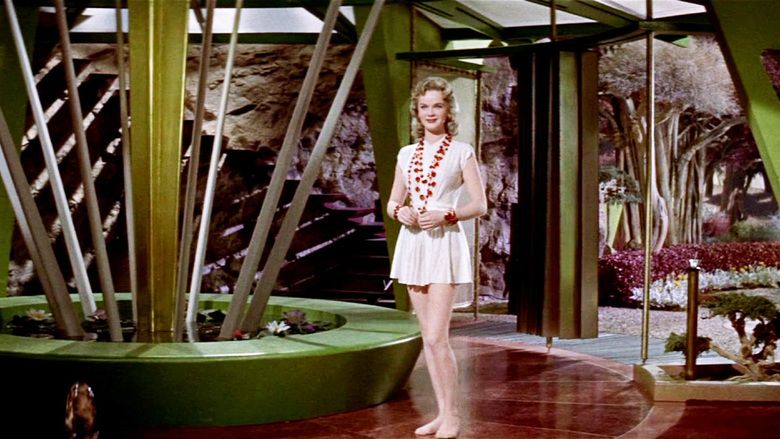
Plot
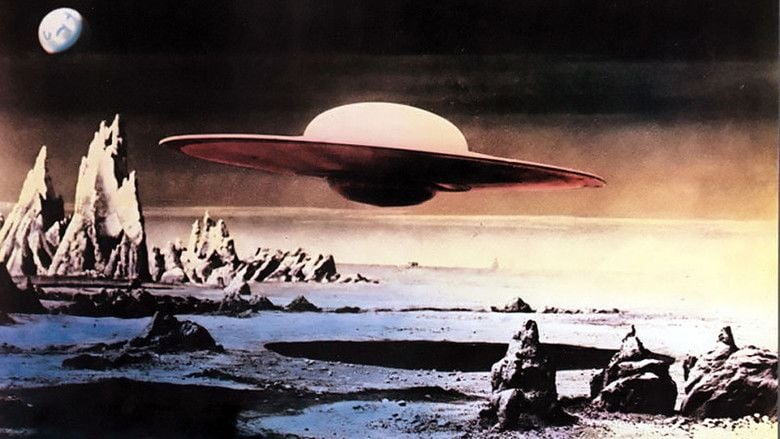
In the 23rd century, starship C-57D reaches the distant world Altair IV to determine the fate of an Earth expedition sent there 20 years earlier. Dr. Edward Morbius, one of the expedition's scientists, unsuccessfully tries to persuade the relief ship not to land, saying he cannot guarantee their safety.
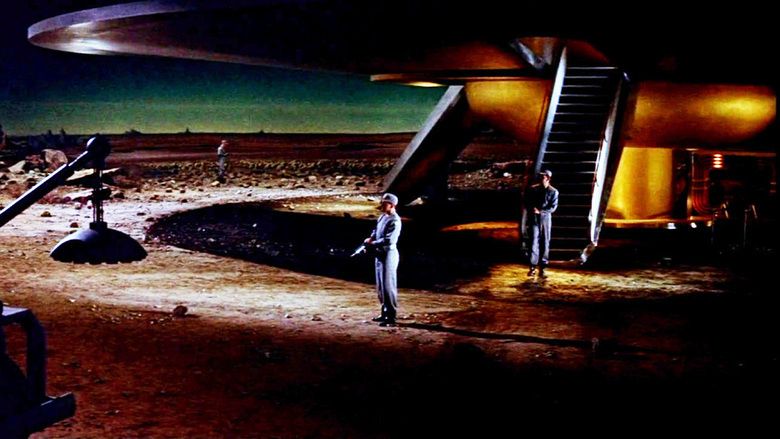
Commander John J. Adams, Lieutenant Jerry Farman, and Lieutenant "Doc" Ostrow are met by Robby the Robot, who transports them to Morbius' residence. Morbius describes how one by one the rest of the expedition was killed by an unknown planetary force that vaporized their starship, the Bellerophon, as the last survivors tried to lift off. Only Morbius, his wife (who later died of natural causes), and their daughter Altaira were somehow immune. Morbius offers to help them prepare for the return journey, but Adams says he must await further instructions from Earth.

The next day, Adams finds Farman teaching Altaira how to kiss; furious, he dismisses Farman and berates Altaira for her naivety and revealing clothing. She reports the incident to Morbius, who says that she never needs to see Adams again. But Altaira designs a new, more conservative gown to please Adams. That night, an invisible intruder sabotages equipment aboard the starship. Adams and Ostrow confront Morbius the following morning. While waiting for him to exit his study, Adams steps outside to talk to Altaira. Adams apologizes for his behavior and they kiss. They are attacked by a tiger, and Adams disintegrates the animal, which had previously been tame in Altaira's presence.
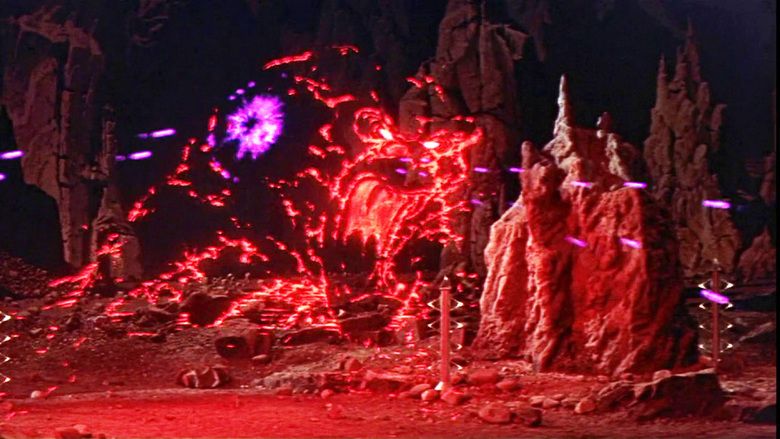
Upon Morbius' appearance, Adams and Ostrow learn he has been studying the Krell, a highly advanced native race that perished overnight 200,000 years before. In a Krell laboratory Morbius shows them a "plastic educator", a device capable of measuring and enhancing intellectual capacity. When Morbius first used it, he barely survived, but his intellect was permanently doubled. Morbius then takes them on a tour of a vast, 20 miles cube, Krell underground machine complex, still functioning and powered by 9,200 thermonuclear reactors. Afterwards, Adams demands that Morbius turn over his scientific discoveries to Earth. Morbius refuses, claiming that "humanity is not yet ready to receive such limitless power".
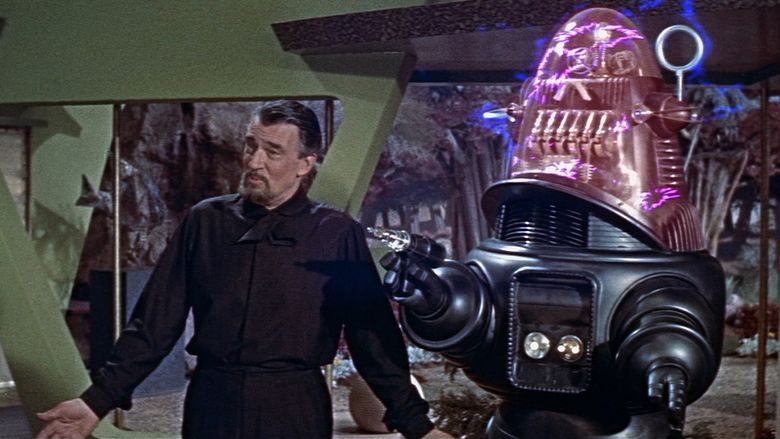
In response to the sabotage, Adams orders a force field fence deployed around the starship. It proves ineffective when the intruder returns and murders Chief Engineer Quinn. Morbius warns Adams that he has a premonition of further deadly attacks, similar to what happened with the Bellerophon. That night, the invisible creature returns and is outlined in the fence's force field. The ship's weapons have no effect, and it kills Farman and two others. Morbius, asleep in the Krell lab, is startled awake by screams from Altaira; at the same instant, the roaring creature vanishes.
Later, while Adams tries to persuade Altaira to leave, Ostrow sneaks away to use the Krell educator. With his dying breath, Ostrow explains to Adams that the underground machine was built to materialize anything the Krell could imagine; creation without instrumentality. He says that the Krell forgot one thing: "Monsters from the Id". The mysterious extinction of the Krell was in fact caused by their own base subconscious, given free reign and unlimited power by the machine. Adams asserts that Morbius' subconscious mind created the creature that killed the members of the original expedition and attacked his crew; Morbius refuses to accept this accusation.
After Altaira tells Morbius that she intends to leave with Adams, Robby detects the creature approaching. Morbius commands the robot to kill it, but Robby knows it is a manifestation of Morbius and shuts down. The monster melts through the almost indestructible Krell metal doors of the laboratory where Adams, Altaira, and Morbius have taken refuge. Morbius finally accepts the truth. He confronts and disowns the creature but is fatally injured. Before Morbius dies, he has Adams unknowingly initiate a chain reaction within the Krell reactors, saying they must be in deep space within 24 hours. At a safe distance, Adams, Altaira, Robby and the surviving crew witness the destruction of Altair IV.
Production
The screenplay by Irving Block and Allen Adler, written in 1952, was originally titled Fatal Planet. The later screenplay draft by Cyril Hume renamed the film Forbidden Planet, because this was believed to have greater box-office appeal. Block and Adler's drama took place in the year 1976 on the planet Mercury. An Earth expedition headed by John Grant is sent to the planet to retrieve Dr. Adams and his daughter Dorianne, who have been stranded there for twenty years. From then on, its plot is roughly the same as that of the completed film, though Grant is able to rescue both Adams and his daughter and escape the invisible monster stalking them.
The film sets for Forbidden Planet were constructed on a Metro-Goldwyn-Mayer (MGM) sound stage at its Culver City film lot and were designed by Cedric Gibbons and Arthur Lonergan. The film was shot entirely indoors, with all the Altair IV exterior scenes simulated using sets, visual effects, and matte paintings.
A full-size mock-up of roughly three-quarters of the starship was built to suggest its full width of 170 ft (51 m). The ship was surrounded by a huge, painted cyclorama featuring the desert landscape of Altair IV; this one set took up all of the available space in one of the Culver City sound stages. Principal photography took place from April 18 to late May 1955.
Later, many costume and prop items were reused in several different episodes of the television series The Twilight Zone, most of which were filmed by Rod Serling's Cayuga Productions at the MGM studio in Culver City, including Robby the Robot, the various C-57D models, the full-scale mockup of the base of the ship (which featured in the famous episode To Serve Man), the blaster pistols and rifles, crew uniforms and special effects shots.
At a cost of roughly $125,000, Robby the Robot was very expensive for a film prop at this time - it represented almost 7 percent of the film's $1.9 million budget and equates to at least $1 million in 2017. Both the electrically controlled passenger vehicle driven by Robby and the truck/tractor-crane off-loaded from the starship were also constructed specially for this film. Robby later starred in the science fiction film The Invisible Boy and appeared in many TV series and films; like the C-57D, Robby (and his passenger vehicle) appeared in various episodes of CBS's The Twilight Zone, usually slightly modified for each appearance.
The animated sequences of Forbidden Planet, especially the attack of the monster, were created by the veteran animator Joshua Meador, who was lent out to MGM by Walt Disney Pictures. According to a "Behind the Scenes" featurette on the film's DVD, a close look at the creature shows it to have a small goatee beard, suggesting its connection to Dr. Morbius, the only character with this physical feature; the bellowing, now visible monster, caught in the crewman's high-energy blaster beams during the attack, is a direct reference to and a visual pun on MGM's familiar roaring mascot, Leo the Lion, seen at the very beginning of Forbidden Planet and the studio's other films of the era. Unusually, the scene in which the Id Monster is finally revealed during its attack on the Earth ship was not created using traditional cel animation. Instead, Meador simply sketched each frame of the entire sequence in black pencil on white paper; each page was then photographed in high contrast, so that only the major details remained visible. These images were then photographically reversed into negative and the resulting white line images were then tinted red, creating the effect of the Id Monster's body remaining largely invisible, with only its major outlines illuminated by the energy from the force-field and blaster beams.
Reception
Forbidden Planet was first released across the U.S. on April 1, 1956 in CinemaScope, Metrocolor, and in some theaters, stereophonic sound, either by the magnetic or Perspecta processes. The Hollywood premiere was held at Grauman's Chinese Theatre, and Robby the Robot was on display in the lobby. Forbidden Planet ran every day at Grauman's Theater through the following September.
According to MGM records the film initially earned $1,530,000 in the U.S. and Canada and $1,235,000 elsewhere resulting in a profit of $210,000.
Forbidden Planet was re-released to film theaters during 1972 as one of MGM's "Kiddie Matinee" features; it was missing about six minutes of film footage cut to ensure it received a "G" rating from the Motion Picture Association of America. Later video releases carry a "G" rating, though they are all the original theatrical version.
The American Film Institute nominated the film for their top 10 science fiction films. The score was nominated for AFI's 100 Years of Film Scores.
Home media
Forbidden Planet was first released in the pan and scan format in 1982 on MGM VHS and Betamax videotape and on MGM laser disc and CED Videodisc; years later, in 1996, it was again re-issued by MGM/UA, but this time in widescreen VHS and laser disc, both for the film's 40th anniversary. But it was The Criterion Collection that later re-issued Forbidden Planet in CinemaScope's original wider screen 2.55-to-1 aspect ratio, on a deluxe laser disc set, with various extra features on a second disc. Warner Bros. next released the film on DVD in 1999 (MGM's catalog of films had been sold in 1988 to AOL-Time Warner by Turner Entertainment and MGM/UA). Warner's release offered both cropped and widescreen picture formats on the same disc.
For the film's 50th anniversary, the Ultimate Collector's Edition was released on November 28, 2006, in an oversized red metal box, using the original film poster for its wraparound cover. Both DVD and high definition HD DVD formats were available in this deluxe package. Inside both premium packages were the films Forbidden Planet and The Invisible Boy, The Thin Man episode "Robot Client" ("Robby The Robot", one of the film's co-stars, was also a guest star in both The Thin Man episode and The Invisible Boy) and a documentary Watch the Skies!: Science Fiction, The 1950s and Us. Also included were miniature lobby cards and an 8 cm (3-inch) toy replica of Robby the Robot. This was quickly followed by the release of the Forbidden Planet 50th Anniversary edition in both standard DVD and HD DVD packaging. Both 50th anniversary formats were mastered by Warner Bros.-MGM techs from a fully restored, digital transfer of the film. A Blu-ray disc edition of Forbidden Planet was released on September 7, 2010.
Novelization
Shortly before the film was released, a novelization appeared in hardcover and then later in mass-market paperback; it was written by W. J. Stuart (the mystery novelist Philip MacDonald writing under the pseudonym), which chapters the novel into separate first person narrations by Dr. Ostrow, Commander Adams, and Dr. Morbius. The novel delves further into the mysteries of the vanished Krell and Morbius' relationship to them. In the novel he repeatedly exposes himself to the Krell's manifestation machine, which (as suggested in the film) boosts his brain power far beyond normal human intelligence. Unfortunately, Morbius retains enough of his imperfect human nature to be afflicted with hubris and a contempt for humanity. Not recognizing his own base primitive drives and limitations proves to be Morbius' downfall, as it had for the extinct Krell. While not stated explicitly in the film (although the basis for a deleted scene first included as an extra with the Criterion Collection's LaserDisc set and included with both the later 50th anniversary DVD and current Blu-ray releases), the novelization compared Altaira's ability to tame the tiger (until her sexual awakening with Commander Adams) to the medieval myth of a unicorn being tamable only by a virgin.
The novel also includes an element never included in the film: when Dr. Ostrow dissects one of the dead Earth-type animals, he discovers that its internal structure precludes it from ever having been alive in the normal biological sense. The tiger, deer, and monkey are all conscious creations by Dr. Morbius using the great machine as companions ("pets") for his daughter and only outwardly resemble their Earth counterparts. Since the Krell's Great Machine can project matter "in any form" it has the power to create life. Thus, the Krell's self-destruction can be interpreted by the reader as a cosmic punishment for misappropriating the life-creating power of the universe. This is why Commander Adams says in his speech to Altaira "... we are, after all, not God."
Upon its publication in 1956, Anthony Boucher dismissed the novelization as "an abysmally banal job of hackwork".
The novelization has a 4.4 star (out of 5 star) rating at Amazon.com
Soundtrack
Forbidden Planet's innovative electronic music score, credited as "electronic tonalities", partly to avoid having to pay any of the film industry music guild fees, was composed by Bebe and Louis Barron. MGM producer Dore Schary discovered the couple quite by chance at a beatnik nightclub in Greenwich Village while on a family Christmas visit to New York City; Schary hired them on the spot to compose his film's musical score. While the theremin (which was not used in Forbidden Planet) had been used on the soundtrack of Alfred Hitchcock's Spellbound (1945), the Barrons' electronic composition is credited with being the first completely electronic film score; their soundtrack preceded the invention of the Moog synthesizer by eight years (1964).
Using ideas and procedures from the book Cybernetics: Or Control and Communication in the Animal and the Machine (1948) by the mathematician and electrical engineer Norbert Wiener, Louis Barron constructed his own electronic circuits that he used to generate the score's "bleeps, blurps, whirs, whines, throbs, hums, and screeches". Most of these sounds were generated using an electronic circuit called a "ring modulator". After recording the basic sounds, the Barrons further manipulated the sounds by adding other effects, such as reverberation and delay, and reversing or changing the speeds of certain sounds.
Since Bebe and Louis Barron did not belong to the Musicians Union, their work could not be considered for an Academy Award, in either the "soundtrack" or the "sound effects" categories. MGM declined to publish a soundtrack album at the time that Forbidden Planet was released. However, film composer and conductor David Rose later published a 7" (18 cm) single of his original main title theme that he had recorded at the MGM Studios in Culver City during March 1956. His main title theme had been discarded when Rose, who had originally been hired to compose the musical score in 1955, was discharged from the project by Dore Schary sometime between Christmas 1955 and New Year's Day. The film's original theatrical trailer contains snippets of Rose's score, the tapes of which Rose reportedly later destroyed.
The Barrons finally released their soundtrack in 1976 as an LP album for the film's 20th anniversary; it was on their very own Planet Records label (later changed to Small Planet Records and distributed by GNP Crescendo Records). The LP was premiered at MidAmeriCon, the 34th World Science Fiction Convention, held in Kansas City, MO over the 1976 Labor Day weekend, as part of a 20th Anniversary celebration of Forbidden Planet held at that Worldcon; the Barrons were there promoting their album's first release, signing all the copies sold at the convention. They also introduced the first of three packed-house screenings that showed an MGM 35mm fine grain vault print in original CinemaScope and stereophonic sound. A decade later, in 1986, their soundtrack was released on a music CD for the film's 30th Anniversary, with a six-page color booklet containing images from Forbidden Planet, plus liner notes from the composers, Bebe and Louis Barron, and Bill Malone.
A tribute to the film's soundtrack was performed live in concert by Jack Dangers, available on disc one of the album Forbidden Planet Explored.
Track list
The following is a list of compositions on the CD:
- Main Titles (Overture)
- Deceleration
- Once Around Altair
- The Landing
- Flurry Of Dust – A Robot Approaches
- A Shangri-La In The Desert / Garden With Cuddly Tiger
- Graveyard – A Night With Two Moons
- "Robby, Make Me A Gown"
- An Invisible Monster Approaches
- Robby Arranges Flowers, Zaps Monkey
- Love At The Swimming Hole
- Morbius' Study
- Ancient Krell Music
- The Mind Booster – Creation Of Matter
- Krell Shuttle Ride And Power Station
- Giant Footprints In The Sand
- "Nothing Like This Claw Found In Nature!"
- Robby, The Cook, And 60 Gallons Of Booze
- Battle With The Invisible Monster
- "Come Back To Earth With Me"
- The Monster Pursues – Morbius Is Overcome
- The Homecoming
- Overture (Reprise) [this track recorded at Royce Hall, UCLA, 1964]
Costumes and props
The costumes worn by Anne Francis were designed by Helen Rose. Her miniskirts were the first ever seen in a Hollywood film, and resulted in Forbidden Planet being banned in Spain; it was not shown there until 1967. Other costumes were designed by Walter Plunkett.
Robby the Robot was operated by diminutive stuntman Frankie Darro. He was fired during filming after almost falling over while in the expensive prop, following a five-martini lunch.
In late September 2015 several screen-used items from Forbidden Planet were offered in Profiles in History's Hollywood Auction 74, including Walter Pidgeon’s "Morbius" costume, an illuminating blaster rifle, blaster pistol, a force field generator post, and an original Sascha Brastoff steel prehistoric fish sculpture seen outside Morbius' home; also offered were several lobby cards and publicity photos.
In popular culture
An Australian radio adaption using the original electronic music and noted local actors was broadcast in June 1959 on "The Caltex Radio Theatre".
In Stephen King's "the Tommyknockers", Altair-4 is frequently referenced as the home planet of the titular alien presence.
In the authorized biography of Star Trek creator Gene Roddenberry, Roddenberry notes that Forbidden Planet "was one of [his] inspirations for Star Trek".
Elements of the Doctor Who serial Planet of Evil were consciously based on the 1956 film.
Forbidden Planet is named alongside ten other classic science fiction films in the opening song "Science Fiction Double Feature" from The Rocky Horror Picture Show.
The British musical Return to the Forbidden Planet was inspired by and loosely based on the MGM film and won the Olivier Award for best musical of 1989/90.
A scene from the science fiction TV series Babylon 5, set on the Epsilon III Great Machine bridge, strongly resembles the Krell's great machine. While this was not the intent of the show's producer, the special effects crew, tasked with creating the imagery, stated that the Krell's machine was a definite influence on their Epsilon III designs.
The Outer Limits episode The Man with the Power revisits the premise of a person’s subconscious manifesting as a destructive, murderous entity.
Cancelled remake
New Line Cinema had developed a remake with James Cameron, Nelson Gidding and Stirling Silliphant involved at different points. In 2007 DreamWorks set up the project with David Twohy set to direct. Warner Bros. re-acquired the rights the following year and on October 31, 2008, J. Michael Straczynski was announced as writing a remake, Joel Silver was to produce. Straczynski explained that the original had been his favorite science fiction film, and it gave Silver an idea for the new film that makes it "not a remake", "not a reimagining", and "not exactly a prequel". His vision for the film would not be retro, because when the original was made it was meant to be futuristic. Straczynski met with people working in astrophysics, planetary geology, and artificial intelligence to reinterpret the Krell back-story as a film trilogy. In March 2009 Straczynski reported that the project was abandoned, and that a new script was requested.
References
Forbidden Planet WikipediaForbidden Planet IMDbForbidden Planet Rotten TomatoesForbidden Planet themoviedb.org
